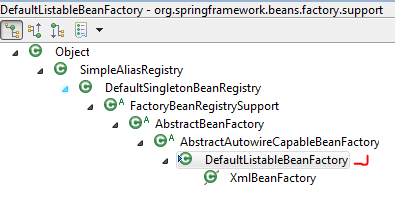文章转载自:http://m.oschina.net/blog/203902
一、@Autowired
作为一个Spring开发者对@Autowired注解必定是非常了解了, 顾名思义自动装配,应该是Spring会自动将我们标记为@Autowired的元素装配好,与其猜测不如看看它的定义:
@Target({ElementType.CONSTRUCTOR, ElementType.FIELD, ElementType.METHOD,
ElementType.ANNOTATION_TYPE})
@Retention(RetentionPolicy.RUNTIME)
@Documented
public @interface Autowired {
boolean required() default true;
}
很明显这个注解可以用到构造器,变量域,方法,注解类型上。文档上这样描述:将一个构造器,变量域,setter方法,config方法标记为被Spring DI 工具自动装配。换句话说,我们视图从bean 工厂中获取一个bean时,Spring会自动为我们装配该bean中标记为@Autowired的元素,而无需我们手动完成。这些相信大家都明白,但问题是,Spring是怎样做到的?在Spring MVC中怎样做到的?什么时候进行的自动装配?下面我们就来探究下这些问题。
二、BeanPostProcessor
在@Autowired的定义中有下面一段话:
Note that actual injection is performed through a BeanPostProcessor
which in turn means that you cannot use @Autowired to inject references into BeanPostProcessor
or BeanFactoryPostProcessor types.
Please consult the javadoc for the AutowiredAnnotationBeanPostProcessor class
(which, by default, checks for the presence of this annotation).
意思是:实际的注入装配动作是由BeanPostProcessor执行的,翻过来说你不能将@Autowired注解用于BeanPostProcessor或BeanFactoryPostProcessor类型上。请查看AutowiredAnnotationBeanPostProcessor文档(默认情况下,被用来检查@Autowired注解)。
文档说的很清楚了,BeanPostProcessor来执行自动装配,并且默认情况下使用AutowiredAnnotationBeanPostProcessor实现类完成。那我们不妨看一下他们的定义:
public interface BeanPostProcessor {
Object postProcessBeforeInitialization(Object bean, String beanName) throws BeansException;
Object postProcessAfterInitialization(Object bean, String beanName) throws BeansException;
}
BeanPostProcessor就一个回调接口,定义了两个方法声明,一个是实例化前被调用,一个是实例化后被调用,没啥好看的,我们直接看看它的实现类AutowiredAnnotationBeanPostProcessor:
BeanPostProcessor implementation that autowires annotated fields, setter methods and arbitrary
config methods. Such members to be injected are detected through a Java 5 annotation:
by default, Spring’s @Autowired and @Value annotations.Also supports JSR-330’s @Inject
annotation, if available, as a direct alternative to Spring’s own @Autowired.
Note: A default AutowiredAnnotationBeanPostProcessor will be registered by
the “context:annotation-config” and “context:component-scan” XML tags.
NOTE: Annotation injection will be performed before XML
injection; thus the latter configuration will override the former for properties
wired through both approaches.
上面是AutowiredAnnotationBeanPostProcessor类的描述文档摘要,大致意思是:这是BeanPostProcessor接口的一个实现,用来自动装配注解的变量域,setter方法和任意的config方法。这些被注入的元素是通过检测Java 5的注解完成的:默认情况下是@Autowired和@Value注解。同样也支持JSR-330的@Inject注解。并且,和XML标签可以默认注册AutowiredAnnotationBeanPostProcessor到bean工厂中。最后,注解注入会在XML注入之前执行;因此后面的配置会覆盖前面已经装配好的元素。
是不是很清楚了?Spring的文档总是这么详细,要么说是教科书呢,废话不多说,我们才刚进正题呢,既然我们清楚了是AutowiredAnnotationBeanPostProcessor实例执行了自动装配,那么它做了什么呢?
三、磨刀砍柴
在正式查看源码前,我先大致的讲一下整个装配的过程,以便后面理解起来轻松些。其实整体思路还是很简单的,我们举个简单的例子:
//==================================Controller
@Controller
public class SimpleController {
@Autowired
private SimpleService simpleService;
}
//==================================Service
@Service(“simpleService”)
public class SimpleServiceImpl implements SimpleService {
@Autowired
private SimpleDao simpleDao;
}
//===================================Repository
@Repository(“simpleDao”)
public class SimpleDaoImpl implements SimpleDao {
}
1)在某一时刻Spring调用了 Bean工厂 的 getBean(beanName) 方法。beanName可能是simpleController,或者simpleService,simpleDao,顺序没关系(因为后面会有依赖关系的处理)。我们假设simpleController吧。
2)getBean方法首先会调用Bean工厂中定义的getSingleton(beanName)方法,来判断是否存在该名字的bean单例,若果存在则返回,方法调用结束。
3)否则,Spring会检查是否存在父工厂,如果有则返回,方法调用结束。
4)否则,Spring 会检查该bean 定义(BeanDefinition实例,用来描述Bean结构,上篇文章讲到过,component-scan 扫描后,就是将beanDefinition实例放入Bean工厂,此时Bean还没有被实例化。)是否有依赖关系,如果有,执行1)步,获取依赖的bean实例。
5)否则,Spring会尝试创建这个bean实例,创建实例前,Spring会检查确定调用的构造器,并实例化该Bean。
6)实例化完成后,Spring会调用Bean工厂的populateBean方法来填充bean实例的属性,也就是我们前面提到的自动转配了。populateBean方法便是调用了BeanPostProcessor实例来完成属性元素的自动装配工作。
7)在元素装配过程中,Spring会检查被装配的属性是否存在自动装配的其他属性,然后递归调用getBean方法,直到所有@Autowired的元素都被装配完成。如在装配simpleController中的simpleService属性时,发现SimpleServiceImpl实例中存在@Autowired属性simpleDao,然后调用getBean(simpleDao)方法,同样会执行1)-7)整个过程。所以可以看成一个递归过程。
8)装配完成后,Bean工厂会将所有的bean实例都添加到工厂中来。
注:我们知道Spring MVC是多线程单实例的MVC框架,就是说,对于同一个Controller,只会生成一个实例来处理所有的请求,因此bean实例只会实例化一次,并被存放在工厂中,以供其他请求使用。
好了,大致了解整个流程后我们看一下Spring的具体行为吧。
四、Bean 工厂
前面多次提到了Bean工厂,但一直没有说它到底是个什么,这里我们就彻底弄清楚吧,省的云里雾里,这样我们后面讲到Bean工厂就不会晕了。看过上一篇博客()的朋友可能记得DefaultListableBeanFactory这个类,当时是它保存了扫描到的组件–Bean Definition实例。那他是否是我们所说的Bean工厂呢?是否保存了Bean实例呢?答案是:对。
我们可以看到DefaultLiableBeanFactory继承自DefaultSingletonBeanRegistry,AbstractBeanFactory,AbstractAutowireCapableBeanFactory。下面就列出了一下相关的Bean工厂中的属性和方法:
//==========================================================================================
//==============================DefaultListableBeanFactory================================
//==========================================================================================
//beanName-beanDefinition 的映射表
private final Map























 5947
5947

 被折叠的 条评论
为什么被折叠?
被折叠的 条评论
为什么被折叠?








